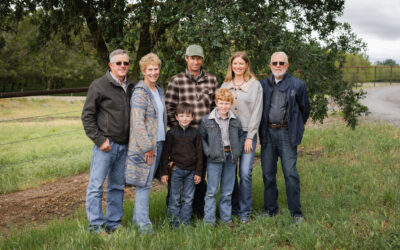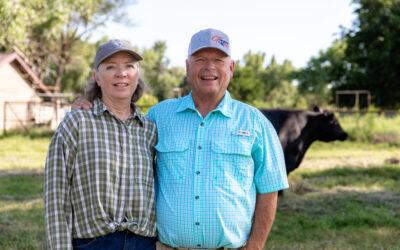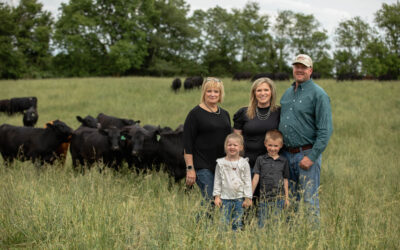Words two live by
“That was probably it,” my gut tells me as I drive past a charming farm house lining a dirt road on the outskirts of Spearman, Texas. I dial the first 8-0-6 number in my recent call list, not sure which brother will be on the other end of the line. It was Chance, who was traveling up from Pampa, Texas, with wife Erica and kids Maddox, Bristol, and Cayler. Sure enough, his twin Collin had already told him they had seen me drive by.
Moments later I am greeted with a gracious hello and hot cup of coffee from Collin and Lacee Bowers. Their sons Casen and Crüe peer up at me below the brims of their cowboy hats and murmur a shy hello. Chance and Collin’s older brother Chandler, his wife Jenna, and daughters Anleigh and Hadleigh arrive soon after.
We venture 20 minutes down the road to the family’s X Cross X ranch – on their mom’s side – where Collin oversees heifer development and farms wheat. The three brothers run a complementing ranching and farming operation of commercial Angus cattle, wheat, corn, cotton and milo. Chandler and Chance manage operations in Pampa, with Chandler heading the farming and Chance the cow-calf aspect.
After photos and a tour of the ranch, we head back to Collin’s house for the ‘official’ with him and Chance. I ask them to describe a week in the life.
“It depends,” is the immediate answer, followed by a chorus of laughter. “Every question can be answered as, ‘it depends.’” No two weeks are the same, as the unpredictable Texas Panhandle climate sees extreme temperatures on both ends of the spectrum. Plans are never permanent, yet planning is still a necessity.
“You can’t live day to day in this operation,” Chance and Collin agree. “You have to be looking ahead of what you’re doing. Not just a week ahead, but months, even years, ahead.”
“Everything is seasonal,” explains Collin. Getting ready to cut corn, plant wheat, wean calves. “It’s always preparation, always a ‘be ready to do this.’”
Long-term planning is essential to building a strong replacement heifer herd. It starts with a great bull, paying particular attention to low birth weight and calving ease EPDs (expected progeny differences). However, selecting the right females is where the money is.
“We keep the heifers that stick with AI or breed with a cleanup bull the first 30 days,” says Chance. “That way you keep fertility in your herd. That’s huge for marketing our calves. We can get a set of calves that are within 10 days of each other. When we go to sell them, they’re all going to weigh the same.”
Farming is vital to sustaining the operation. When either the cattle or crop market falls, the other is usually able to balance the books. Wheat also enhances the cattle operation; one of this year’s goals is to feed steers and cull heifers all the way through to the feedlot.
“We try to get everything on wheat,” says Collin. “It’s a great way to get them up to that feeder weight.”
“The cost of gain on wheat depends on the year,” says Chance. “The bigger we can get [steers] into the [feedlot], it’s going to be a happy medium.”
Yet there is a component of business planning that does not pertain to cattle and crops.
“The hardest part is the generational deal,” says Collin. “The first one builds it, the second enjoys it, and the third one loses it, is how that usually goes.”
But, “We’re fourth and fifth generation…and we’re not only keeping it together, we have expanded it,” says Chance. “Everything’s everyone’s in our family. It’s a family partnership.”
The brothers have already started to instill in their kids the lessons passed down through all generations of the Bowers and Lackey families.
“You’ve got to educate your kids so they know what they’ve got. And how to handle keeping it going,” says Chance. “We’re where we are today because our dad drilled that responsibility into our heads.”
“And work ethic,” reminds Collin.
Time, and a proven family track record of preparing the next generation for responsibility. As we bid our farewells and I head out the driveway, I can’t help but feel proud of the Bowers family. Their enduring spirit has sustained through the Depression, the Dust Bowl, and countless droughts. It is truly an impressive story, and one I am grateful to share.
May your day be bright and your smile brighter,
Diane
You may also like
Legacy in the Golden Land
On a quiet stretch of Northern California rangeland, a different story unfolds. The Borror family’s legacy modestly speaks through the cattle they raise, the ground they steward. The generations who’ve made a life here demonstrate commitment to doing things right, even when no one is watching.
Helping Hands, Helping Herds
“When I die, I want to come back as one of your cows,” murmurs a friend to Steve Zybach. Full to the brim from an alfalfa ration every day, bountiful fields of lovegrass stretched out across the Texas Panhandle—and owners who leave no ounce of cattle care up for question. The Zybachs’ motivation for this level of dedication to their Angus cattle is simply love.
An Ambassador for All
Joanie, with daughter Lindsey and her husband, Adam Hall, raise registered Angus cattle with two primary goals: producing high-quality seedstock that perform well in a wide variety of environments and ensuring end-user satisfaction. Those goals tie everything together, from promoting Angus to other producers to sharing their story with CAB partners and beef consumers.







